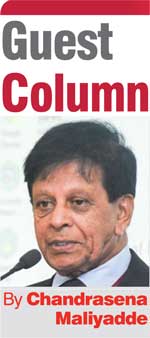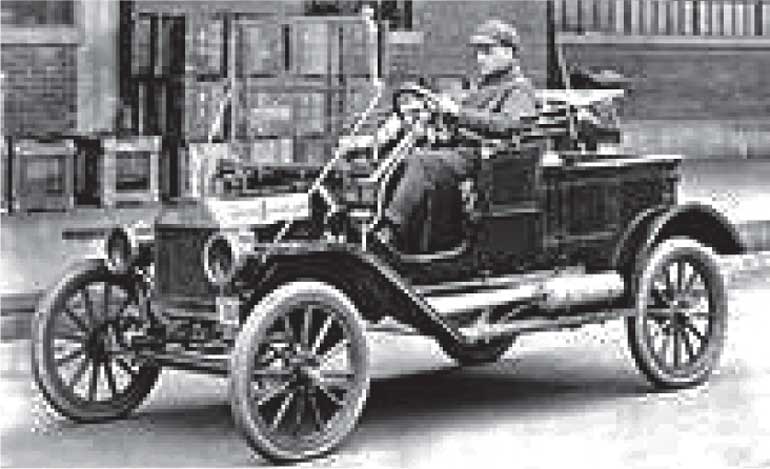Friday Dec 12, 2025
Friday Dec 12, 2025
Tuesday, 28 October 2025 00:20 - - {{hitsCtrl.values.hits}}

The Government can and should play the leading role in the market economy with the right mixture of supportive ingredients
 Background
Background
I was invited to make the Guest Speech on “The role of Government in a market economy” at the 10th Peradeniya International Economic Research Symposium jointly organised by the Department of Economics, University of Peradeniya and the Faculty of Economic Sciences and Business Administration of Transilvania University of Brasov, Romania on 11 September. This article is based on my presentation at the symposium.
Turning the economy to market-oriented
Since independence, Sri Lanka followed a protected, import-substitution-led, State-command economic model, with variations under different regimes. During the early 1970s, a six-year Development Plan was designed and implemented. It was the only Economic Plan implemented in Sri Lanka over the last 77 years. Several State-owned commercial and manufacturing entities were established to drive the macro economy. Complimentary to the macro-economic drive, a host of small-scale Government-financed projects were implemented at the Divisional Secretariat level aimed at income and employment generation.
There were restrictions imposed by the Government on the movement of commodities within the island and with the rest of the world. I had to surrender my marriage certificate to buy a suit length for my wedding dress and stand in queues to collect some infant milk food for my one-year old son. Amidst these hardships and restrictions, I believe that the interventions of the Government paved the way for a future manufacturing economy.
In 1977, a new Government was elected. In presenting the maiden Budget, the Minister of Finance declared that there will not be any more Government controls on the availability, movement or, price of commodities. It will be left for the market (the demand and supply) to decide. A market-driven economy replaced the State-command economy, taking a 180-degree turn. The following day, while I was walking down the corridors of the Treasury, I met the then Director, National Planning. He said Chandre, there will not be much work for us anymore. I was puzzled and asked him what had happened. He responded that “the economy will be market-driven; the Government (planning) has no role in it”.
Market optimises resource allocation
Market economy is based on the concept that the market forces driven by profit motives of private players could ensure optimal resource allocation; determine winners and losers; government intervention risks distortion. This was first theorised by Adam Smith, who introduced the concept of ‘the invisible hand’. The ideal role of the government in a market economy is to address “market failures”, and to protect, maintain, facilitate, and allow the market forces to work.
The government is expected to ensure national defence, introduce laws and regulations to control pollution and external costs, provide education, health that generates external benefits, deliver public goods that are jointly consumed and are not profit generating, define and enforce a Legal and Social Framework, maintain and promote competition, engage in programs to support income and social welfare, and introduce Fiscal and Monetary Policies to regulate the economy. The government’s role is limited and passive in a market economy.
 Consumer is no longer the king
Consumer is no longer the king
Unfortunately, the world we live in today is different from that which Adam Smith knew. No country operates with completely uninhibited pure free markets. All markets are in some ways constrained. Markets are not perfect; demand is not price elastic. Markets are manipulated and distorted. Consumer is not the king anymore.
According to the World Bank, more than 30% of the population lives below the poverty line in Sri Lanka. The richest 20% of the population earns 50% of the national income and the poorest 20% earns only 6%. The top 1% owns 31% of the wealth, and the bottom 50% owns 4%. The share of the Western Province of the GDP is 40%. These statistics show that the perfect free market is only a theoretical environment found in textbooks.
Market is imperfect and inelastic
Where the market is imperfect, inelastic, and influenced by factors beyond demand and supply, and fails to deliver socially optimal outcomes, Government intervention is called for. The market needs to be regulated, watched, and diverted. The Government has to facilitate the market and market players. Government has to lay the roadmap. It has to show the direction, it has to raise the alarms.
Ioannis Kampourakis – Erasmus University Rotterdam (EUR) – Erasmus School of Law in his article on ‘The market as an instrument of planning in sustainability capitalism’ (https://papers.ssrn.com/sol3/papers.cfm?abstract_id=4446810) states: “Recent policies for sustainability transitions in the United States (USA) and the European Union (EU) (eg, Infrastructure Law, EU Green Deal) have signaled aspirations for a more prominent role of the state in coordinating the economy, while still relying primarily on market mechanisms for such coordination. Acknowledging the deliberate and artificial character of markets raises the question of what we want markets for, broadening the scope of the political possibilities enclosed in them.”
Within the span of a decade, China created the world’s largest electric vehicle market. The Government in China recognised from early days the potential behind the transition from Internal Combustion Engine Vehicles (ICEVs) to Electric Vehicles, or New Energy Vehicles (NEVs). The Government promoted the vehicle manufacturers with purchase subsidies, regulations favouring NEVs in urban environments, foreign direct investment, and mandatory NEV quotas in automobile manufacturing by employing a planned, government-led approach, China proved that planning is possible not only beyond but also within markets.
Fishing in troubled water
In Sri Lanka, with the introduction of the market economy, the Government expected the private sector to be the engine of growth. But the country lacks a risk-bearing private investor and entrepreneur community. Further, as indicated by the US Department of State in its latest report on 2025 Investment Climate Statements: Sri Lanka, “Overall, investors report that doing business remains difficult, frequently citing concerns about project reversals, regulatory shifts, slow decision making, and inadequate support for established businesses.” (file:///C:/Users/DELL/Documents/Documents_Articles/Recent%20Statements_IMF_World%20Bank/Sri%20Lanka%20%20United%20States%20Department%20of%20State.html).
In this background, the market economy was troubled water for the businessmen who were involved in risk-free transfers to do fishing. The result was an unbearable, massive trade deficit with a mountain of debt.
Government achieves what the market failed
In 1989, the late President Premadasa introduced a series of programs and provided impetus to harness the private sector participation in the development. Jansaviya went beyond a mere poverty alleviation program. It had a production component and a fund created with Janasaviya Bank. This was complementary to the 1.5 million rural housing program and the Gamudawa program.
Private sector players, for the first time, stepped into remote rural areas with the 200 regional garment factory program. The Government supported with land, duty-free concessions on imports, infrastructure such as electricity, water, access road, telecommunication facilities and export quotas. These interventions and the initiatives by the Government opened up opportunities for the private sector participation in the periphery that the market economy failed to achieve. This is a classic example of how the dormant private sector in the market economy got activated in the development process by the Government initiatives. The Government can and should play the leading role in the market economy with the right mixture of supportive ingredients.
Market is both the supply and demand
Investment, products, and factors are moving towards where the profits are. Not where the needs are. Profits are gained by the producer, not by the consumer. The market discriminates against the consumer and favours the producer. Economists who promote the market economy advocate against Government interference in the market. By market, they mean the supply (producer) only and not the demand (consumer). They encourage the Government to intervene in the demand to create opportunities for the producer (supply). They advocate that the Government enhance the consumer’s purchasing power through offering subsidies, tax exemptions, grants, concessions, and social security benefits named in multiple ways. It’s not for the mercy towards the consumer but the producer.
Influencing and luring the demand
Advertisements and promotions lure consumers by creating desire and providing incentives, using tactics like emotional appeals, social proof, scarcity tactics, and limited-time discounts. Key methods include using compelling visuals and sounds, celebrity endorsements, personalised marketing through social media, and targeted promotions. Consumer is thoroughly influenced and confused. This is why a man who pawns his wife’s jewellery and enters into a supermarket to buy a bottle of milk for his toddler leaves with a bottle of arrack under his armpit.
There are new, different modes of payment apart from traditional methods like cash and checks, such as debit/credit cards, digital options, digital wallets, bank transfers, and mobile payments. Emerging methods are also available, including “Buy Now, Pay Later” (BNPL) services and cryptocurrency. These modes are to lure the consumer (the demand) to expand the market for the benefit of the producer (the supply).
Products are vertically diversified
Further, the products are diversified not only horizontally but vertically as well.
This is how the internet describes the first automobile built in 1896:
“Henry Ford’s first automobile, the Quadricycle, was a four-wheeled, gasoline-powered vehicle built in 1896. It had a two-cylinder, four-horsepower engine, and its frame was made of angle iron. It used a tiller, had a two-speed transmission, and weighed 500 pounds”.
Look at the newspaper advertisement below that appeared recently:
“Alloy wheels, Tiptronic, Leather interior, Electric memory seats, Rear power door, Zenon lights, Bluetooth, Push start, Fully loaded, with panoramic sunroof, Side reverse camera, TV/DVD, 6 speed, Automatic transmission”.
We can see how the automobile is vertically diversified. This is common for many products, if not for all.
Conclusion
I have cited these events, incidents, and scenarios to show that the market economy is not something God-given which operates smoothly for optimal resource allocation, leading to the sustained creation of wealth and economic prosperity and well-being. The Government is not a dormant, passive player in the market economy but the, leading, dominant, decisive player. The Government is in the driving seat, which should steer, and direct the market to reach the aspired destination. It has to correct imbalances. It has to ensure economic and social justice. Government plays a dominant, powerful, and proactive role in a market economy.
(The writer is the former Secretary, Ministry of Plan Implementation and at present Vice President of Sri Lanka Economic Association and the Organisation of Professional Associations. He can be reached at [email protected].)